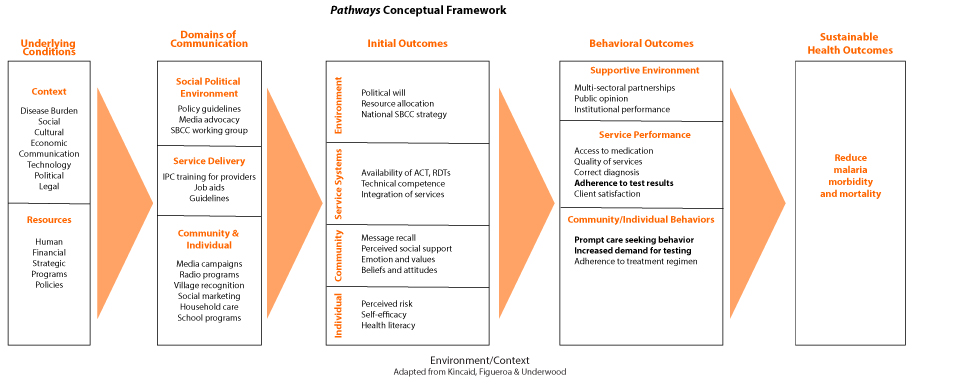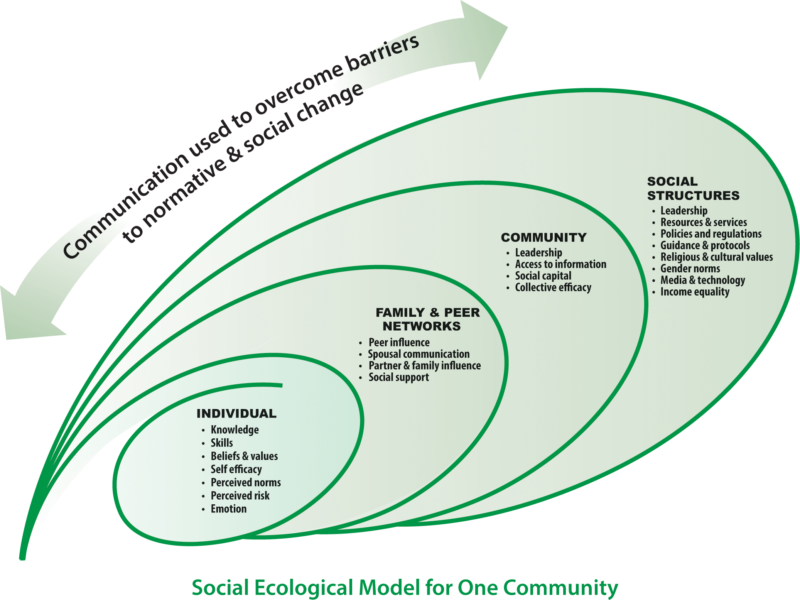
Develop a Theory-Based Behavioral Model
Develop a way to visualize how specific behaviors are influenced and how to measure changes
The next steps to developing an M&E plan include developing a theory-based behavioral model and pairing it with an M&E framework. A behavioral model shows which influences will bring about change, while an M&E framework shows how program outputs, outcomes, and impact are linked and measured with specific indicators.
Both your behavioral model and M&E framework should be based on your root cause analysis, and previously developed problem statements. In the framework above three key malaria case management SBCC behaviors are bolded (under behavioral outcomes). Underlying conditions, domains of communication, and initial outcomes related to these behaviors are likely to have come up during the root cause analysis. Recognizing the connection between the different levels of structural, social, and individual influences on behavior, and illustrating them in a model, help visualize and make sense of how to plan monitoring and evaluating for each.
A theory should inform your behavioral model (your model simply illustrates how your chosen theory applies to a specific situation, like malaria case management behaviors), and your model will then help you place program outputs, outcomes, and impact into an M&E framework. For example, suppose you chose Bronfenbrenner's ecological system theory. This theory simply states that behavior is explained by individual, social, and structural influences. Drawing a series of concentric rings, with these levels of influence labeled to show how malaria case management behaviors come about, is a model. Some models are more complex, and show different stages of change in sequence (see more examples below). Once your behavioral model is complete all there is left to do is determine how, where, and when to program and measure specific inputs, outcomes, and impact.
More examples of behavioral models
Monitoring and Evaluation Framework
Map the logical progression of objectives, inputs, major activities, outputs, outcomes, and impact
Behavioral models can be used to assist in the development of a framework to show the logical progression between the SBCC program activities and expected results on the target population. This model will help to plan how to capture, record, and report behavior changes over time. The monitoring and evaluation framework below shows how to operationalize a model to achieve specific outcomes and impact. This example framework includes case management-specific indicators from the RBM Malaria SBCC Indicator Guide.
Note that another term for an M&E framework is a logic model.
How-To Guide Guidance on how to develop a logic model
How-To Guide Step-by-step guidance on developing a M&E plan for social and behavior change programs
| Program Outputs | Communication Outcomes | Behavior Outcomes | Health Impact |
|---|---|---|---|
| Access to SBCC Interventions Increased | Knowledge and Attitudes Toward Malaria Behaviors, Products, and Services Improved | Practice of Healthy Malaria Behaviors Increased | Health Outcomes Improve |
| SBCC Outputs
# materials produced (on what, for whom) # people reached (with what or by whom) # SBCC activities (for) # people trained (in what) | Knowledge & Awareness
% who can (correctly) name mosquitoes as cause of malaria % who (correctly identify) know the main symptom of malaria % who know the (correct) treatment for malaria % who (correctly identify) know prevention measures | Behavior
% children >5 with fever in the last two weeks for whom advice or treatment was sought % fever cases receiving a malaria diagnostic test % tested cases treated/not treated according to test results | |
| Reach/Exposure
% who recall hearing or seeing any (or program-related) malaria message in the last 6 months | Risk & Efficacy
% who feel at risk for malaria % who feel that the consequences of malaria are serious % who believe prompt care seeking for fever will reduce risk of severe malaria % who are confident in their ability to seek care for fever promptly | Malaria Morbidity & Mortality Reduced | |
| Norms & Attitudes
% with a favorable attitude toward prompt care seeking for fever % who believe the majority of their friends and community seek care for fever promptly |
Assumption: Enabling environment exists - updated policies, availability of commodities and services
Select Appropriate Indicators
It is necessary to decide which indicators will best measure changes in the audience and behavior described in your problem statement, and illustrated in your behavioral model. The indicators below have been developed by the Roll Back Malaria SBCC Working Group. The list below is not the comprehensive list, but a selection of those relevant to malaria case management SBCC interventions. Download the M&E framework below and begin populating it with relevant malaria case management SBCC indicators.
How-To Guide Guidance on how to develop indicators
Note the difference between communication outcomes and behavior outcomes. Communication objectives are knowledge, attitudes, discussion (within family, community, providers, etc.), acceptance and approval, and personal advocacy (all of which influence future intentions), while behavior objectives are practices that have been directly linked to improvements in morbidity and mortality. Changes in communication objectives are important behavioral predictors that can be tracked over time to monitor whether or not a program is making progress towards changing behavior. Communication objectives should articulate how a program will change antecedents like knowledge, attitudes, discussion, approval, and personal advocacy, while behavior objectives should articulate which practices directly associated with reductions in morbidity and mortality will be changed.
| Inputs | Process | Outputs | Intermediate outcomes | Outcomes | Impact |
|---|---|---|---|---|---|
| # resources used | Activity reports | # of people exposed | Correct knowledge, positive attitudes | % practicing behavior | % decrease in malaria-related morbidity and/or mortality |
If you receive USAID funding, you may need to complete a performance indicator reference sheet for each indicator as a part of an overall performance management plan.
Download M&E Framework Template


